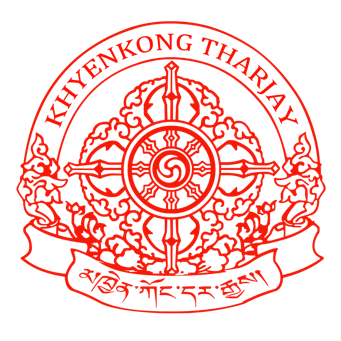History of the Great Jamyang Khyentse Wangpo’s Lineage
Khyentse Incarnations
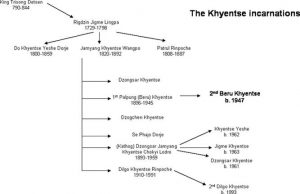
The 1st Jamyang Khyentse Wangpo was a great master of the non-sectarian lineage holder of the Tibetan Vajrayana Buddhism (1820-1892).
Jamyang Khyentse Wangpo was the emanation of great Bodhisattva Manjushri. Although he had attained Buddhahood from the very beginning, he still continued to appear in this realm of beings as a Bodhisattva, to liberate the last of the beings from the sufferings of the cyclic existence. As a Bodhisattva, he has performed infinite profound and secret activities for the benefit of sentient beings of all the Worlds.
In India, he emanated as:
Manjushrimitra – the Great Pandita of India,
Vimalamitra – the great pandita from the Five Peaks of Manjushri, Wui Tai Shan, China, (view image) and Phadhampa Sangye – the great mahasiddha from India.(view image)
In the land of Tibet, there have been various emanations of this bodhisattva that appeared to benefit sentient beings, such as:Chogyal Trisong Deutsen -Dharma King of Tibet who invited Guru Rinpoche for the establishment of the Vajrayana Buddhism. (view image) Gyalsay Lhaje Chokdup Gyalpo, one of the first thirteen tertons. (view image)
Teachers
1st Beru Khyentse Rinpoche
The Speech reincarnation of Jamyang Khyentse Wangpo (1895 – 1945)
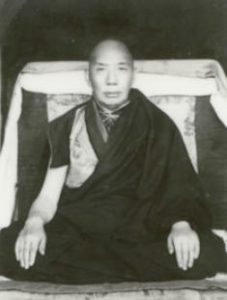
Beru Khyentse (Karma Jamyang Khyentse Ozer)
Beru is the name of Hor Kingdom’s royal family. Karma denotes association with the Kagyupa sect and his main seat is the Palpung Monastery in Derge, which is also the main seat of its founder, Tai Situpa.
Later in his life, the Great Jamgon Kongtrul Lodro Thaye spent most of his time at his main seat Tsandra Rinchen Drak. One of Jamgon Kongtrul Rinpoche’s close disciples who was also Dzogchen Paltrul Rinpoche’s disciple, named Gonpo Dudul, was also the King of the Tre-hor Beru family. He was a very spiritual person and all his activities were related to the Dharma. One day he visited Jamgon Kongtrul Rinpoche at Tsandra Rinchen Drak to offer his respect. Whilst there, Jamgon Kongtrul Rinpoche predicted that his wife will conceive very soon and this boy is the speech emanation of Jamyang Khyentse Wangpo. He told him that if Palpung Monastery wishes to take care of this child, he should not refuse. He advised him not to miss this opportunity and to keep this matter as secret for a while. At this time, Beru Khyentse’s father, Gonpo Dudul had no idea that his wife was pregnant. When he returned he found his wife was indeed pregnant and she later gave birth to a boy as predicted by Jamgon Kongtrul Rinpoche. The Beru family had only one boy and an elder daughter, so the family members wanted to keep the boy as heir to the throne of the Beru King. But since Jamgon Kongtrul Rinpoche had already mentioned about the boy to the father, therefore he accepted the advice and gave the child to Palpung Monastery.
Jamgon Kongtrul Rinpoche also said that his main disciple, abbot Tashi Ozer, would take care of the child. He predicted the child as the speech emanation of Jamyang Khyentse Wangpo of the Kagyu Lineage at the Palpung Monastery.
2nd. Beru Khyentse Rinpoche
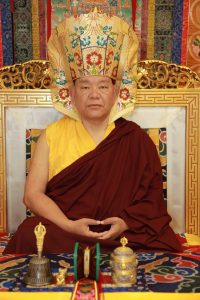
2nd Beru Khyentse Choyi Wangpo Rinpoche 2004Jamyang Khyentse Wangpo’s third incarnation, manifestation of mind, the present Palpung Beru Khyentse or Drongsar Khyentse Chokyi Wangpo was born in 1947 (15th day of 6th lunar month) in Central Tibet, 25 km west of Lhasa in Nyethang region.
In 1955, His Holiness 16th Gyalwa Karmapa Rangjung Rigpe Dorje, through his clairvoyance predicted the child to be true incarnation and mind emanation of Jamyang Khyentse Wangpo. In the case of this Bodhisattva the circumstances leading to expression of his Dharma activities are as follows:-
The primary cause of the expression of Dharma activities of third incarnation of Jamyang Khyentse Chokyi Wangpo could be attributed to the merits of prayers and very pure faith, samaya or pledge of two of the Karmapa’s most extraordinary and close disciples. Having incomparably perfect faith and keeping pure samaya, courageous in both religious and political matters, one of the four internal major ministers or Behu title of the Nangchen King, popular far and wide for their glory and dexterity, was born in Drongsar family. Both Drongsar Behu Drakpa Namgyal and his younger brother Drongsar Behu Namkha Dorje requested His Holiness the Gyalwa Karmapa for a high ranking Kagyu Lama capable of guiding the innocent beings and to hold the Dharma seat of their newly constructed monastery.
The Karmapa accepted their request with joyful kindness and produced a recognition letter containing all the necessary details for his recovery. It stated that the child was to be found:
“In the snow land region of the Central Tibet in straight forward western direction, two days journey away from Tsurphu for the swift walker. The fathers name being Nga Gi Wang Chuk Drowegon – The Lord of Speech, the protector of beings, and the mother’s name is Arya Tara Chokyidron. The child born in the Fire-Dog year, belonged to a family with noble spiritual background and displayed special signs, is the reincarnation of Khyentse Wangpo without a doubt”.
These were the exact words or the contents of the recognition letter.
 Dregpa Namgyal – Founder of 2nd Beru Khyentse’s ReincarnationThereafter a search party was organized, comprising of Karmapa’s attendant Yeshi Choephel and Drongsar Drakpa Namyal’s attendant Tsultrim Woeser. For ten days they searched everywhere in the predicted direction. Finally, their efforts were rewarded and they reached the Tulku’s birthplace.
Dregpa Namgyal – Founder of 2nd Beru Khyentse’s ReincarnationThereafter a search party was organized, comprising of Karmapa’s attendant Yeshi Choephel and Drongsar Drakpa Namyal’s attendant Tsultrim Woeser. For ten days they searched everywhere in the predicted direction. Finally, their efforts were rewarded and they reached the Tulku’s birthplace.
This village was in accordance with the recognition letter, in straightforward direction from central Tibet ( Lhasa ), towards upper southern part of the course of Kyichu River . The swift walker as mentioned in the recognition letter was, later realized to have been alluded to a horse, because this place was at a distance of two days horse ride from Karmapa’s main seat of Tsurphu and about a mile from a very sacred pilgrimage site, called Nyethang, which has a Tara temple.
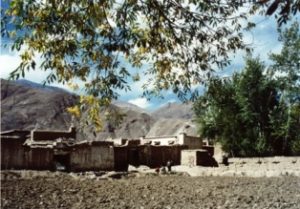 Beru Khyentse’s Birth place, Nyethang Valley, near Lhasa
Beru Khyentse’s Birth place, Nyethang Valley, near Lhasa
The famous Buddhist Pandita of Bengal, Dipamkara or popularly known as Atisha stayed nine years on this place and eventually performed the act of passing into parinirvana at this place. The village where tulku had taken birth is called Nyethang Jemanang. His mother and uncle were from a rich family but after marriage they stayed with his father who was from a modest family as predicted in the recognition letter. Also the door of their house faced east in confirmation with the recognition letter.
His father’s name was Ngawang Lobsang and that the mother’s was Dolma or Arya Tara in Sanskrit. The couple had three children, two daughters and the youngest, a son was recognized later as the reincarnation of Jamyang Khyentse Wangpo. The race of the parents conformed to the noble family background mentioned in the letter. The father was of Ling stock from Kham Dayab Dungra. Ling is a race famous for conquers and battles. Ling Gesar, the famous king and conqueror was also from this race.
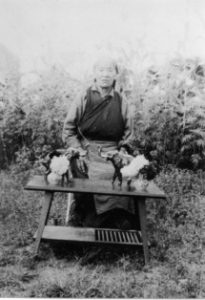 Beru Khyentse’s Mother, DrolmaRinpoche’s birth was accompanied with many auspicious signs. At one time, while his mother was working in the field and Rinpoche in her womb, his mother found a bone idol of Yamantaka in the field. And just before Rinpoche’s birth, she found a swastika or a mystical cross made of bell metal outside her house. This was considered a spiritual sign. A few days after this incident, she saw perched on the walnut tree near their house, a strange white bird never seen before and it bowed many times towards their house before disappearing. This meant that the protectors were looking after them.
Beru Khyentse’s Mother, DrolmaRinpoche’s birth was accompanied with many auspicious signs. At one time, while his mother was working in the field and Rinpoche in her womb, his mother found a bone idol of Yamantaka in the field. And just before Rinpoche’s birth, she found a swastika or a mystical cross made of bell metal outside her house. This was considered a spiritual sign. A few days after this incident, she saw perched on the walnut tree near their house, a strange white bird never seen before and it bowed many times towards their house before disappearing. This meant that the protectors were looking after them.
Rinpoche was born on the anniversary day of Gampopa’s parinirvana, at the dawn of full moon day of the sixth month of Fire-Pig year, 16th Rabjung or the 16th cycle sixty-year of Tibetan calendar in 1947, without any difficulty to his mother. That very day they discovered that a big mushroom had grown on the flat stone surface under the water barrel in the kitchen. During the birth of Rinpoche, his mother heard a Khampa beggar calling her from their doorsteps for alms. Later she realized that it was a sign that the child would have to leave his birthplace and move to the land of Khampas . Since taking birth, the color of the child changed everyday. A few days after the birth of the child when mother went out of the house she found a Guru Rinpoche’s gold-plated statue made of pure copper. This meant that Guru Rinpoche is spiritually connected to Jamyang Khyentse Wangpo.
Rinpoche started his religious studies at the age of three. He entered Nyethang Tashi Gang Monastery; a Sakya Monastery founded by Drogon Choegyal Phakpa. He studied rituals and underwent spiritual training in the monastery until the age of nine. For instance, he would behave as if building a temple or a monastery. Sometimes Rinpoche would sit atop a stone throne and appoint officials from among other children. He would say, “You are my personal attendant, you would be the abbot and chanting master, you will be altar and shrine master and so on”. Then they would pretend to be praying and sometimes, Rinpoche would act as if he is giving a religious discourse. He used to make and keep many bell and damaru shaped stones.
It was said that the local people used to marvel at the unique behavior of the child. They used to say that his child is very special or he must be an incarnation of a holy person. Once, when Rinpoche attended a prayer at Tashi Gang Monastery, a big mushroom bloomed from a dry pillar of the prayer hall and astonished all the monks. Rinpoche’s childhood name was Thupten Sherap the ‘sublime wisdom of Buddha’s doctrine’. True to his name he was very intelligent. He could understand the meaning of texts by just one teaching or going through it just once.
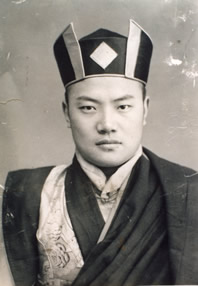 His Holiness the 16th Karmapa, his first photo given to Beru Khyentse Rinpoche for blessing, 1955 in TibetIn 1955, when Rinpoche was nine years old the two search parties setting out to look for the Yangsi Beru Khyentse Rinpoche reached Nyethang. As the search parties were passing through a road beside Rinpoche’s house, the young Rinpoche saw and followed them. Not knowing he is the one that they were looking for, and fearing for some mischief, the search parties moved on cautiously. After going about a mile they reached the residence of the district leader. They saw many people thrashing and winnowing wheat and barley corps. They asked the gathering about the family and the child they are looking for. One of Rinpoche’s cousins’ sister Acha Pekyi who was working there heard them. She told them that their description resembled her family and directed them to the house. When they again reached the house by the road, they saw the same child playing with some of his friends. The children were busy drawing pictures of monastery on the ground. They steadily approached the children and asked, among them who were born in the year of dog. All the children except the one whom they saw earlier fled in fear of the Kampa people (search party). He replied that he was born in the year of dog. So, they thought he must be the child they are looking for and went to ask his mother. Rinpoche’s mother told them that her son was born in the year of pig. She said that there was no child born in the year of dog in her family. Having said so, she did not receive them, as she did not want to lose her only son.
His Holiness the 16th Karmapa, his first photo given to Beru Khyentse Rinpoche for blessing, 1955 in TibetIn 1955, when Rinpoche was nine years old the two search parties setting out to look for the Yangsi Beru Khyentse Rinpoche reached Nyethang. As the search parties were passing through a road beside Rinpoche’s house, the young Rinpoche saw and followed them. Not knowing he is the one that they were looking for, and fearing for some mischief, the search parties moved on cautiously. After going about a mile they reached the residence of the district leader. They saw many people thrashing and winnowing wheat and barley corps. They asked the gathering about the family and the child they are looking for. One of Rinpoche’s cousins’ sister Acha Pekyi who was working there heard them. She told them that their description resembled her family and directed them to the house. When they again reached the house by the road, they saw the same child playing with some of his friends. The children were busy drawing pictures of monastery on the ground. They steadily approached the children and asked, among them who were born in the year of dog. All the children except the one whom they saw earlier fled in fear of the Kampa people (search party). He replied that he was born in the year of dog. So, they thought he must be the child they are looking for and went to ask his mother. Rinpoche’s mother told them that her son was born in the year of pig. She said that there was no child born in the year of dog in her family. Having said so, she did not receive them, as she did not want to lose her only son.
That evening the search party took shelter in the Nyethang Ratod Monastery about three miles from the village. The abbot of the monastery gave them a warm reception, and asked them about their purpose of visit. They told them that His Holiness Gyalwa Karmapa sent them to trace the reincarnation of Beru Khyentse Rinpoche. Furthermore, they told him about their failure to trace the reincarnation even after ten days of searching in the specified area.
The abbot told them to leave the recognition letter with him for the night so that he could test his dream. The next morning the abbot confirmed that as per his dream, they have already found the reincarnation. He told them that in his dream he saw a huge golden boulder underneath the land of Nyethang Jemanang village, and that its golden rays have prevailed all over the sky above. He further said that although he had heard of Karmapa, but never knew before that he was such a clairvoyant lama. A sense of deep involuntary devotion developed in him for the Karmapa and he sent offerings to express his devotion. With all this information they returned to Tsurphu and reported everything to Karmapa, including the non-conformity of the year of birth. The Karmapa explained that there was not any non-conformity in the year of birth as the child was indeed conceived in the year of dog but born in the year of pig. Thus, the Karmapa untied the hundred knots of doubts arising due to the year of birth of the Tulku.
 Letter of Title & Rank from HH 16th KarmapaIn 1955, the age of nine he was formally recognized as the incarnation of late Beru Khyentse. His Holiness the 16th Gyalwa Karmapa sent Lama Osung, the Vajra Master of Tsurpu monastery to perform water purification ceremony. He performed the ceremony for a week and offered him the robes sent by Karmapa. However, withdrawing Rinpoche from the monastery faced a complex situation as he was already a monk of Tashi Gang Sakya Monastery and disciples of that monastery were binding on him. Even Karmapa as the head of Kagyu school has no authority to withdraw a lama or monk from monastery of another school.
Letter of Title & Rank from HH 16th KarmapaIn 1955, the age of nine he was formally recognized as the incarnation of late Beru Khyentse. His Holiness the 16th Gyalwa Karmapa sent Lama Osung, the Vajra Master of Tsurpu monastery to perform water purification ceremony. He performed the ceremony for a week and offered him the robes sent by Karmapa. However, withdrawing Rinpoche from the monastery faced a complex situation as he was already a monk of Tashi Gang Sakya Monastery and disciples of that monastery were binding on him. Even Karmapa as the head of Kagyu school has no authority to withdraw a lama or monk from monastery of another school.
Drongsar Drakpa Namgyal was very well acquainted with and close to H.H. Sakya Trizin Rinpoche and Sakya Dagmo Kushok’s brother, Mr. Tashi Parey, an administrative officer of the Tibetan Government. Through their help all the obstacles were dispelled. Moreover, Sakya Trizin Rinpoche granted Rinpoche all the ranks and authority of a high Sakya Lama of the rank of Ngor Khenchen. The authorization letter was written on a piece of yellow silk brocade.
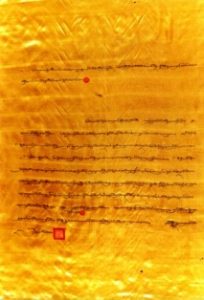
Letter of Title & Rank from HH Sakya Trizin
Thereafter, Drakpa Namgyal visited the Tashi Gang Monastery and make offerings to Rinpoche’s family and also to all the monks in the monastery according to the custom. The New Year first enthronement ceremony of Rinpoche was held in Tashi Gang Monastery itself.
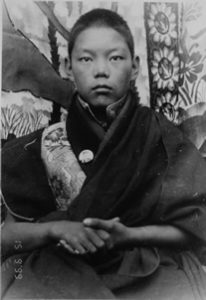 2nd Beru Khyentse’s Photo 13 years old (1959)In 1956, when Rinpoche was ten years old, he visited the Tsurphu Monastery along with his family. H.H. Gyalwa Karmapa and the monks of the Tsurphu monastery gave him a warm reception. The Karmapa performed the hair cutting ceremony, robes offering and the naming ceremony. He was named Karma Drubgyud Tenpa Yarphel Gyurmey Gocha Trinley Kunkhyap Palzangpo. His Holiness, with great kindness handed over his own Gampopa hat and offered robes to Rinpoche. As requested by Drakpa Namgyal, the Karmapa composed a long life prayer for Rinpoche and also gave him an authorization letter on a piece of yellow silk brocade entitling him all the power and rights of Kagyu Gyalwa Yabsey or high-ranking Rinpoche of the Kagyu lineage.
2nd Beru Khyentse’s Photo 13 years old (1959)In 1956, when Rinpoche was ten years old, he visited the Tsurphu Monastery along with his family. H.H. Gyalwa Karmapa and the monks of the Tsurphu monastery gave him a warm reception. The Karmapa performed the hair cutting ceremony, robes offering and the naming ceremony. He was named Karma Drubgyud Tenpa Yarphel Gyurmey Gocha Trinley Kunkhyap Palzangpo. His Holiness, with great kindness handed over his own Gampopa hat and offered robes to Rinpoche. As requested by Drakpa Namgyal, the Karmapa composed a long life prayer for Rinpoche and also gave him an authorization letter on a piece of yellow silk brocade entitling him all the power and rights of Kagyu Gyalwa Yabsey or high-ranking Rinpoche of the Kagyu lineage.
The authorization letter was endorsed with the Karma Pakshi’s seal in the presence of all the monks. The Karmapa gave him Getsul ordination vows and later the secret tantra vows. This included the long-life empowerment of Machig Dubpey Gyalmo, Karma Pakshi Empowerments, Grand Mahakala Yab-Yum empowerments along with all the five retinues. Since Drakpa Namgyal was very close to Karmapa, he requested that the young Tulku should have all the qualities such as beauty and grace as possessed by the Karmapa himself. Following that, the Karmapa first touched his own face and then the young Tulku’s face and said, “I bestow all the beauty and handsomeness possessed by my face to the young Rinpoche. Now you should be satisfied”. He further assured him that he had the true incarnation of Beru Khyentse Rinpoche.
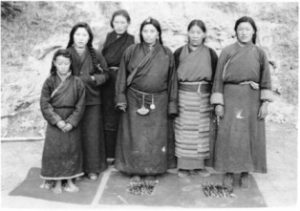 At that time previous Karmapa Khakhyab Dorje’s consort Khandro Ogyen Tsomo was also residing at the Tsurphu monastery. As the 2nd Beru Khyentse was her root lama, she felt extremely happy to see his reincarnation and came to pay respect with offerings. In fact all the lamas, monks and staff of Tsurphu monastery were disciples of the previous incarnation. They have high respect to the Yangsi Rinpoche.
At that time previous Karmapa Khakhyab Dorje’s consort Khandro Ogyen Tsomo was also residing at the Tsurphu monastery. As the 2nd Beru Khyentse was her root lama, she felt extremely happy to see his reincarnation and came to pay respect with offerings. In fact all the lamas, monks and staff of Tsurphu monastery were disciples of the previous incarnation. They have high respect to the Yangsi Rinpoche.
Thereafter, Rinpoche and his family returned home to Nyethang to prepare for the long journey to Nangchen, east Tibet. In Lhasa they met non-sectarian master, Dzongsar Khyentse Chokyi Lodro and Rinpoche received from him the White Tara long-life empowerment. He met Sakya seat holder Dolma Phodrang Samphel Wangi-Gyalpo and received Sakya Tsewang Thangyal empowerments and blessings. Drakpa Namgyal then invited and escorted Rinpoche and his family, including his Mother, sister Tsewang Dolma and uncle from Lhasa to Chamdo in a vehicle. At the same time in Nangchen, the people of Drokshok area, comprising of both monks’ community and lay people were preparing for the reception under the guidance and supervision of Drongsar Namkhe Dorje. Rinpoche’s new seat was at a place called Drongsar Yobshung Tashi Khyilwa, in the middle of Nangchen region. H.H the 16th Karmapa named his new seat Pal Karme Chodey Dongag Shedrup Thepten Tharjay Namgyal Ling. The monastery had over 300 monks with an active three-year retreat centre.
Namkhe Dorje organized many stages of reception. The first reception was carried out at Chamdo by a group of people headed by manager Norbu Phuntsok. The second stage of reception had been organized at Kham Rivoche. At this stage of reception, Lama Karma Thrinley Rinpoche, Jedrung Rinpoche and Shabdrung Rinpoche were also present. Karma Thrinley Rinpoche was recognized as reincarnation of Garchen Choje Lama by 16th Karmapa was also one of the lamas from Rinpoche’s monastery.
The Tharjay Monastery, Ven. Lama Zoepa Rinpoche together with Ven. Lhachok Rinpoche and many monks accorded the third reception to Rinpoche’s party at Jammey Monastery. Namkhe Dorje himself with more that a thousand mounted horsemen received Rinpoche at the fourth stage of reception at Jowo Palgyi-Kha Karma Thang. The clerical community comprising of Ven. Sachu Rinpoche and monks community of Kagyu monasteries such as Tharjay monastery, Dhilyak monastery, Kyodrak monastery and Rabjor Monastery were also present. In addition to this, monks of Gelugpa School ‘s Dudgya monastery and Sakyapa School ‘s Pal-bis Lachen and Lachung monasteries were also present. This huge gathering, which saw everyone in their best of their dress and decorated horses, welcomed Rinpoche with ritual playing of the musical instruments and holding big umbrellas, banners, flags and circumambulated Rinpoche.
For the fifth reception at Lep-Karmar, H.E Dazang Rinpoche came along with many other lamas and monk. During the tea offering to Rinpoche, a religious speech and holy discourse was delivered by Ven. Kunsang Tharjay, a learned master from Sakya School ‘s Lachen monastery. After a journey of many days they finally reached their destination.
During Rinpoche’s enthronement, over ten thousand people were present. Among them were many lamas, Tulkus, khenpos and monks from Kagyu, Nyingma, Sakya and Gelugpa schools. In addition to this, people from all over the Drokshok area attended the enthronement. A huge gathering of non-sectarian Sangha welcomed the young Rinpoche by taking out a clerical procession. To welcome the young Rinpoche, the monks of Dhilyak monastery performed the Snow Lion dance.
As soon as Rinpoche sat on the throne, offerings of auspicious symbols, khatak and mandala were made. Following this, a discourse on the significance of the Mandala was made by Chodrak Monastery’s Khenpo Wonpo Apam, Dhilyag monastery’s Khenpo Geshe Tsegyam and Nangchen King with his son, Lama Khenchen Namsang. These discourses explained in detail what each of the articles offered in the mandala signified. For example, the statue offered to the Rinpoche symbolized the body, long life and good health. The scriptures offered symbolized the thought and the good qualities it possess and signified the turning of Dharma Wheel. Offering of the stupa symbolizes understanding the Dharmakaya and the unchanging loving and compassionate mind of Rinpoche benefiting all the sentient beings.
 Beru Khyentse Rinpoche’s benefactor, Bongsar Namkha Dorje, he is brother of Bongsar Behu Dragpa Namgyal taken in Tso PemaAll these programs ran smoothly without obstacles right from the beginning until the end. After that, Rinpoche started his education and training. He started rituals and underwent spiritual training in the Kamtsang Kagyu tradition, learning to read and memorizing of texts under Lama Dodhey. He received many empowerments, teachings and oral transmissions from Lama Buddha and Lama Dorje. They were all learned and very highly realized Dharma practitioners. At the age of eleven, Rinpoche entered his first retreat to do Ngondro practice and Phowa. In between, Rinpoche would accept the request of individuals and general public to give blessings, to perform prayers and to give teachings, empowerments and oral transmissions. At a very young age Rinpoche started to sow the seeds of emancipation from the transmigratory existence.
Beru Khyentse Rinpoche’s benefactor, Bongsar Namkha Dorje, he is brother of Bongsar Behu Dragpa Namgyal taken in Tso PemaAll these programs ran smoothly without obstacles right from the beginning until the end. After that, Rinpoche started his education and training. He started rituals and underwent spiritual training in the Kamtsang Kagyu tradition, learning to read and memorizing of texts under Lama Dodhey. He received many empowerments, teachings and oral transmissions from Lama Buddha and Lama Dorje. They were all learned and very highly realized Dharma practitioners. At the age of eleven, Rinpoche entered his first retreat to do Ngondro practice and Phowa. In between, Rinpoche would accept the request of individuals and general public to give blessings, to perform prayers and to give teachings, empowerments and oral transmissions. At a very young age Rinpoche started to sow the seeds of emancipation from the transmigratory existence.
In 1958, when Rinpoche was twelve years old, there were some troubles related to the Cultural Revolution instigated by the Chinese. For this reason and as it was important for the young Rinpoche to meet the Karmapa and to go to his birthplace on pilgrimage. So, the Drongsar brothers contacted the Chinese Government and obtained permission to this effect. Hence, Khyentse Rinpoche with his family, monks and the two Drongsar brothers with their subjects started on seemingly an official pilgrimage to the Central Tibet , but in reality initiated their exodus from Tibet.
While they were in the presence of the Karmapa at Tsurphu Monastery, they heard news of Cultural Revolution becoming more aggressive. During this hectic period Rinpoche continued with his Dharma practices, studies and teachings. In 1959, when they were traveling through the northern Tibetan region, Rinpoche gave empowerment and oral transmissions of Phowa to a large gathering. Besides that, Rinpoche consistently performed the Tara Puja every morning and Mahakala puja every evening. Rinpoche also regularly practiced the yearly and monthly puja such as the annual summer retreat and the bi-monthly confession ceremony. Rinpoche and his followers did not face many obstacles on the way. Whenever they were in a state of hesitation, they would miraculously get some help. For example, if they are lost and not sure of the way, they would meet some pilgrims who would appear out of nowhere, and after giving directions and cautioning them of any risks, disappeared suddenly. This happened to the party when they were passing through the northern desert region. Even though, they had lost their way in the desert, an old man would suddenly appear out of nowhere and showed them the direction and then disappeared after a moment. Such instances happened often to the party. All the people in Rinpoche’s group were aware that these were the Dharma protectors guiding them day and night.
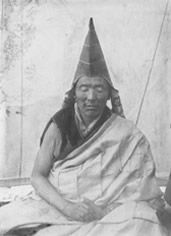 The Great non-sectarian scholar Dzongsar Khenpo Chime Rinpoche ; the 2nd Beru Khyentse Rinpoche’s tutor. After a long journey, Rinpoche, the Drongsar brothers and their followers reached the Nepalese territory of Mustang , the Nepal-Tibet border Jang Tsokar. Thus, it became possible for the group to stay there. They continued to move towards the capital city of Nepal through Pokhara. On reaching Kathmandu , they went to Boudhanath and had a vision of golden countenance of Karmapa. They requested and sponsored H.H. the Karmapa to perform the Black hat adorning ceremony and also took advice in respect of the future course of action to be taken. For the time being, however, they decided to return to the Lo area as the climate at Kathmandu was very hot, resulting in many people dying. About fifteen people from Rinpoche’s group passed away within a few months and Rinpoche himself fell ill. However, he recovered soon due to the blessing of the Karmapa.
The Great non-sectarian scholar Dzongsar Khenpo Chime Rinpoche ; the 2nd Beru Khyentse Rinpoche’s tutor. After a long journey, Rinpoche, the Drongsar brothers and their followers reached the Nepalese territory of Mustang , the Nepal-Tibet border Jang Tsokar. Thus, it became possible for the group to stay there. They continued to move towards the capital city of Nepal through Pokhara. On reaching Kathmandu , they went to Boudhanath and had a vision of golden countenance of Karmapa. They requested and sponsored H.H. the Karmapa to perform the Black hat adorning ceremony and also took advice in respect of the future course of action to be taken. For the time being, however, they decided to return to the Lo area as the climate at Kathmandu was very hot, resulting in many people dying. About fifteen people from Rinpoche’s group passed away within a few months and Rinpoche himself fell ill. However, he recovered soon due to the blessing of the Karmapa.
When they returned to the Lo area they came to know that Dzongar Khenpo Chime, a close disciple of Dzongsar Khyentse Chokyi Lodro has arrived at Lo. Drongsar Drakpa Namgyal approached him personally and made known to him the close-disciple relationship that he shared with Dzongsar Khyentse Rinpoche. He further requested him to take the responsibility of educating the reincarnation of Beru Khyentse. Dzongar Khenpo Chime Rinpoche accepted this request and agreed to become his teacher. Unfortunately, later that year, Drongsar Drakpa Namgyal fell ill and after many months of facing his illness, he passed away in 1960. The responsibility to support Rinpoche, the monks and his followers was handed to his younger brother, Drongsar Namkhe Dorje.
After sometime Rinpoche, Namkhe Dorje and their followers left for Nyeshang ‘Manang’ as many people have been requesting Rinpoche to visit them for quite sometime. At the age of fourteen, Rinpoche began his philosophy education from Khenpo Chime. In the beginning, Khenpo Chime gave him an explanation of Manjushri prayer and then Rinpoche memorized various root texts and studied grammar. Khenpo Chime then gave commentaries on Bodhisattvacaryavatara five times on different occasions.
That year during the monsoon retreat of forty-five days, traditionally, on the last days of the retreat, the lamas and khenpos would gave teachings all through the night. On that occasion, Rinpoche preached on the root text and explanation of the Bodhisattvacaryavatara for three hours without reference. This was the first preaching conducted by Rinpoche.
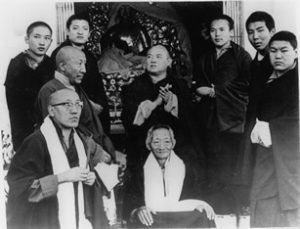 High Rinpoches of the Kagyupa Order Lineage. Left (from top to bottom): Sharmarpa Rinpoche, Gyalsab Rinpoche and the late Pawo Rinpoche. Centre (middle & bottom): The late His Holiness 16th Karmapa, the late Kyabje Kalu Rinpoche. Right (from top to bottom) : Situpa Rinpoche, the late 3rd Jamgon Kongtrul Rinpoche. And the 2nd Beru Khyentse Rinpoche.Gradually, in 1961, Rinpoche, monks and the lay followers moved to India and were united with Namkhe Dorje in Tso Pema or Rewalsar, a holy place of Guru Rinpoche. The monastic community led by Rinpoche stayed in this holy place for four years. The rest of the people worked at various road constructions site in different places such as Kulu and Manali. Rinpoche received many teaching from his master during their stay in Tso-Pema. These included Abhidharma, Prajnaparamita Alankara, Three Trays of Madhyamika, Three Yana Certainty, Gampopa’s ‘Jewel Ornament of Liberation’, Uttaratantra of Maitreya, Getsul Karika, grammar, vocabulary, poetry and handwriting in different scripts. Thus, Rinpoche studied under the guidance of Khenpo Chime Rinpoche for five years. Due to the kindness and compassion, Rinpoche has become a learned master.
High Rinpoches of the Kagyupa Order Lineage. Left (from top to bottom): Sharmarpa Rinpoche, Gyalsab Rinpoche and the late Pawo Rinpoche. Centre (middle & bottom): The late His Holiness 16th Karmapa, the late Kyabje Kalu Rinpoche. Right (from top to bottom) : Situpa Rinpoche, the late 3rd Jamgon Kongtrul Rinpoche. And the 2nd Beru Khyentse Rinpoche.Gradually, in 1961, Rinpoche, monks and the lay followers moved to India and were united with Namkhe Dorje in Tso Pema or Rewalsar, a holy place of Guru Rinpoche. The monastic community led by Rinpoche stayed in this holy place for four years. The rest of the people worked at various road constructions site in different places such as Kulu and Manali. Rinpoche received many teaching from his master during their stay in Tso-Pema. These included Abhidharma, Prajnaparamita Alankara, Three Trays of Madhyamika, Three Yana Certainty, Gampopa’s ‘Jewel Ornament of Liberation’, Uttaratantra of Maitreya, Getsul Karika, grammar, vocabulary, poetry and handwriting in different scripts. Thus, Rinpoche studied under the guidance of Khenpo Chime Rinpoche for five years. Due to the kindness and compassion, Rinpoche has become a learned master.
In 1963, while Rinpoche was studying philosophy at Tso-Pema, H.H. the Gyalwa Karmapa came on a pilgrimage. It was at this time that Rinpoche received from His Holiness, the oral transmissions of Ngondro or ‘Preliminary Practice’ and the Guru Yoga of Karmapa himself. At this time, H.H. the Karmapa presented a vajra, a bell and a piece of brocade to Beru Khyentse Rinpoche. H.H. the Karmapa also advised Rinpoche to receive oral transmissions and empowerments of his ‘gongter’ or mind treasure text of Vajrakilaya from Dilgo Khyentse Rinpoche and practice it daily. Rinpoche obeyed and followed the advice of Karmapa. When Sakya Trizin Rinpoche visited Tso-Pema, Rinpoche received oral transmission and empowerments of Sakyapa’s Thirteen Golden Dharma, Mahakala Gurkyi Gonpo and Vajrayogini. That same year when Kyabje Kalu Rinpoche visited Tso-Pema, Namkhe Dorje met and requested him to give oral transmissions and empowerments necessary for the practices in the retreat to Rinpoche and the other monks. Kyabje Kalu Rinpoche accepted his request with joyful kindness.
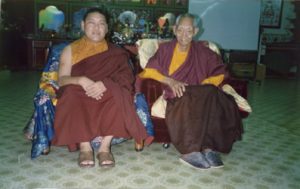 Kyabje Kalu Rinpoche as great master and high realisation of Tibet. He is root Guru of Beru Khyentse Rinpoche. Photo taken in Kuala Lumpur, Malaysia, 1988
Kyabje Kalu Rinpoche as great master and high realisation of Tibet. He is root Guru of Beru Khyentse Rinpoche. Photo taken in Kuala Lumpur, Malaysia, 1988
Thus, in the sacred land of Tso-Pema, Beru Khyentse Rinpoche received complete empowerments and oral transmissions of Chikshey Kundrol as well as empowerments of all the peaceful and wrathful deities and those of about forty-two yidams. He also received empowerments and the oral transmissions of Chagchen Ngedon Gyatso (Definitive Meaning Mahamudra) or (Mahamudra Text Ocean of Certainty), Ngedon Donme Marig Munsel (Torch of Certainty Eliminating the Darkness of Ignorance), and Kunzung Lamey Shelung ((Words of Perfect Guru). Kyabje Kalu Rinpoche gave the complete empowerments and oral transmissions for the three year three months retreat to the first batch of retreat entrants in exile that was organized up in the hills of Tso-Pema. At that time, Rinpoche was eighteen years old and stayed up in the hill retreat centre for five months and practiced Mahamudra preliminary practice of the Kagyu Tradition.
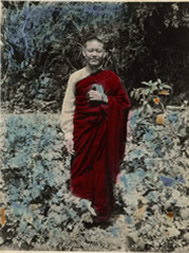 Beru Khyentse Rinpoche at age of 16 in Guru Rinpoche’s Holy Lotus Lake (Tsopema) in West India, H.P.
Beru Khyentse Rinpoche at age of 16 in Guru Rinpoche’s Holy Lotus Lake (Tsopema) in West India, H.P.
In 1965, following their earnest request, Rinpoche and his family, Namkhe Dorje and his family, the monastic community and followers of about five hundred people, settled in the central Indian state of Madhya Pradesh, in a place called Mainpat, in the eastern region of the state. Thus, due to the kindness of H.H. the Dalai Lama and H.H. the Gyalwa Karmapa, and the guidance of Central government of India , the Nangchen camp no. 2 were established. Mainpat, which is situated on a high plateau four thousand feet above sea level, is very isolated and has a remarkable countryside.
Meanwhile, Beru Khyentse Rinpoche continued with his philosophy studies by revising those which he had already studied, and went through those texts which he had not yet studied. A the same time, Rinpoche gave teachings to his students on Bodhisattvacaryavatara many times, Gampopa’s ‘Jewel Ornament of Liberation’, Zapmo Nangdon (Profound Inner Meanings), Domsum Namnge (Three Yana Certainty), Getsul Karika, Nagarjuna’s Suhridalekha texts, and Asangha’s thirty-seven practices of Bodhisattva etc. He also taught them grammar and handwritings of different scripts.
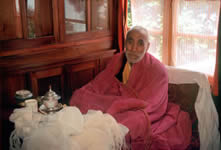 The Great non-sectarian scholar Khunu Lama Tenzin Gyaltsen Rinpoche; the 3rd Beru Khyentse Rinpoche’s Mahamudra and Dzongchen teacher.In 1967, Kyabje Kalu Rinpoche wrote a letter to Khyentse Rinpoche saying that Rinpoche has studied well and acquired knowledge comparable to any learned man. Therefore as a Kagyupa, practice, meditation and comprehension is more important. He further advised Rinpoche to enter the three-year retreat saying that he should do it now while he had time otherwise when Rinpoche’s Dharma activities flourished later, he would not have the opportunity to do so. Rinpoche accepted this kind advice and replied in affirmation entering into retreat.
The Great non-sectarian scholar Khunu Lama Tenzin Gyaltsen Rinpoche; the 3rd Beru Khyentse Rinpoche’s Mahamudra and Dzongchen teacher.In 1967, Kyabje Kalu Rinpoche wrote a letter to Khyentse Rinpoche saying that Rinpoche has studied well and acquired knowledge comparable to any learned man. Therefore as a Kagyupa, practice, meditation and comprehension is more important. He further advised Rinpoche to enter the three-year retreat saying that he should do it now while he had time otherwise when Rinpoche’s Dharma activities flourished later, he would not have the opportunity to do so. Rinpoche accepted this kind advice and replied in affirmation entering into retreat.
In 1968, Rinpoche made a pilgrimage to Varanasi , where H.H. Sakya Trizin Rinpoche was giving teaching on Lamdre and Sakyapa’s Thirteen Golden Dharma. Rinpoche received complete teachings along with many other lamas and khenpos. At that time Kyabje Kalu Rinpoche, who was also in Varanasi , kindly visited Rinpoche specifically to give him empowerments, oral transmissions, instructions and teaching necessary for the three years three months retreat.
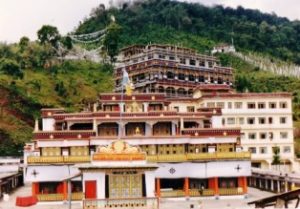 These teachings were conducted in the Karma Kagyu tradition and consisted of different Mahamudra scriptures, many higher yidams and teachings of Naropa’s Six Yogas, teachings of Dakini Machig Lamdron’s Chod practices which cut through demonic interference and many other teachings.
These teachings were conducted in the Karma Kagyu tradition and consisted of different Mahamudra scriptures, many higher yidams and teachings of Naropa’s Six Yogas, teachings of Dakini Machig Lamdron’s Chod practices which cut through demonic interference and many other teachings.
That same year at the age of twenty-one, Rinpoche entered into retreat along with eight other monks and some retreat masters. That was the second batch of retreat entrants organized in exile by Beru Khyentse Rinpoche’s retreat centre. The retreat centre was situated in the forest, at an isolated place in the outskirts of the Nangchen camp. As Kalu Rinpoche was Palpung’s retreat master, the rules and regulations adopted in this retreat centre were in accordance with those in Tsurphu and PRumtek Monastery in Sikkim (karmey Chogar), the main seat of H.H. 16th Karmapaalpung retreat centres.
During Naropa’s Six Yoga practice, Kyabje Kalu Rinpoche kindly and purposely visited Mainpat to give detailed instructions and guidance throughout the six yogas and to introduce the Mahamudra to Rinpoche and the other retreat monks. Kyabje Kalu Rinpoche is a main root Guru of Beru Khyentse Rinpoche and had been very kind to him like spiritual father.
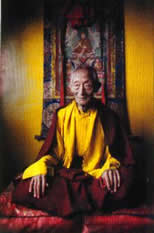 Kyabje Kalu Rinpoche as great master and high realisation of Tibet. He is root Guru of Beru Khyentse Rinpoche. Photo taken in Kuala Lumpur, Malaysia, 1988
Kyabje Kalu Rinpoche as great master and high realisation of Tibet. He is root Guru of Beru Khyentse Rinpoche. Photo taken in Kuala Lumpur, Malaysia, 1988
In 1972, at the age of twenty-six, Rinpoche successfully completed his retreat of four years without any obstacles. In the same year Rinpoche visited Bodhgaya on pilgrimage and received teaching from Khunu Rinpoche Tenzin Gyaltsen, who was a very great Rime master, scholar and learned saint. Rinpoche received from Khunu Rinpoche detailed instructions and oral transmission of the 3 rd Karmapa, Rangjung Dorje’s Mahamudra teaching, and also oral transmissions and instructions of the great Dzogchen ascetic Shri Singha’s composition ‘Tsig-sum Nad-dek’.
 Beru Khyentse Rinpoche at 27 years of age in Calcutta W.B., IndiaIn 1973, at the age of twenty seven, Rinpoche visited Rumtek Monastery and met with H.H. the Gyalwa Karmapa. He received from Karmapa intensive Mahamudra teachings such as very special secret teachings of Mahamudra and of Mahakala Bernagchen. H.H. the Gyalwa Karmapa bestowed inconceivable kindness to Rinpoche by direct mind to mind introduction of his true perceptions, by introducing him to Contemplation of Meaning of Tantric Treatise and Changchen Ku-nga or Introducing Mind by means of the Five Kayas During those days the Gyalwa Karmapa made many wonderful predictions about the future and also gave a lot of advice. For instance, one evening when all the Rinpoches were performing the Mahakala Puja with Gyalwa Karmapa, he suddenly said to Jamgon Kongtrul Rinpoche that, just now, a child has been born in the east of Sikkim . He is destined to slap your face when he grows up. One day he advised all the Rinpoches to refrain from getting involved in politics. He said that we are Dharma practitioners and should not get mixed up with politics. If we perform our Dharma practices well, then we will have success and good luck spontaneously. It is the job of politicians to indulge in politics and they are good at it. Politics is not our cup of tea. This advice is really becoming true now.
Beru Khyentse Rinpoche at 27 years of age in Calcutta W.B., IndiaIn 1973, at the age of twenty seven, Rinpoche visited Rumtek Monastery and met with H.H. the Gyalwa Karmapa. He received from Karmapa intensive Mahamudra teachings such as very special secret teachings of Mahamudra and of Mahakala Bernagchen. H.H. the Gyalwa Karmapa bestowed inconceivable kindness to Rinpoche by direct mind to mind introduction of his true perceptions, by introducing him to Contemplation of Meaning of Tantric Treatise and Changchen Ku-nga or Introducing Mind by means of the Five Kayas During those days the Gyalwa Karmapa made many wonderful predictions about the future and also gave a lot of advice. For instance, one evening when all the Rinpoches were performing the Mahakala Puja with Gyalwa Karmapa, he suddenly said to Jamgon Kongtrul Rinpoche that, just now, a child has been born in the east of Sikkim . He is destined to slap your face when he grows up. One day he advised all the Rinpoches to refrain from getting involved in politics. He said that we are Dharma practitioners and should not get mixed up with politics. If we perform our Dharma practices well, then we will have success and good luck spontaneously. It is the job of politicians to indulge in politics and they are good at it. Politics is not our cup of tea. This advice is really becoming true now.
In 1974, the Gyalwa Yabsay namely, H.H. Gyalwa Karmapa, Shamar Rinpoche, Situ Rinpoche, Jamgon Rinpoche, Gyaltsab Rinpoche and Beru Khyentse Rinpoche and many other Rinpoches, khenpos, lamas, and monks visited Bumthang Tashi Choling in Bhutan. During this visit Gyalwa Karmapa built a Monastery there and conducted a summer retreat with all the other Rinpoches, khenpos, lamas and monks. On the final week of forty-five days monsoon retreat, each and every Rinpoche was to give a Dharma discourse, selected through the drawing of lots. The first lot drawn by Gyalwa Karmapa was that of Beru Khyentse Rinpoche. Rinpoche preached on Gampopa’s ‘Jewel Ornament of Liberation’ full text and the commentaries for four hours without referring to any book and notes. After staying in Bhutan for a couple of months, they returned to Rumtek Monastery, where Rinpoche sought His Holiness’ permission to return to Mainpat to visit his mother, sister’s family and the monks.
 Beru Khyentse with H.H. Dalai Lama, Bodhgaya 1979
Beru Khyentse with H.H. Dalai Lama, Bodhgaya 1979
On his way from Sikkim to Mainpat in 1974, Rinpoche attended the Grand Kalachakra Empowerment being given by H.H. the Dalai Lama at Bodhgaya. Prior to this, Rinpoche had received the first Kalachakra Empowerment given by H.H. the Dalai Lama at his summer palace, the Norbu Lingka, Lhasa , Tibet in 1954. The late Jamgon Kongtrul Rinpoche was also present to receive this Kalachakra Empowerment. At that time Beru Khyentse Rinpoche was seven year old and was not acquainted with Jamgon Kongtrul. Although both of them were yet to be recognized and enthroned, yet their karmic connections were so strong that they were brought together for this grand empowerment. Nevertheless, Beru Khyentse Rinpoche received this empowerment the third time from H.H. the Dalai Lama in Bodhgaya in 1985. Thus, Rinpoche had received Kalachakra empowerment three times as well as many other teachings such as the commentary on Shantideva’s Bodhisattvacaryavatara twice, Uttaratantra of Maitreya Ngul-chu Thogmed, Asangha’s thirty-seven practices of Bodhisattva, mind-training teachings called Lobjong Nyime Oser, teachings of Khunu Rinpoche Tenzin Gyaltsen’s compositions Jangchub Semtod or ‘Praise to the Enlightened Mind’, Atisha’s Teachings on Jangchub Lamdron or the Torch of Bodhisattva’s Path, Gampopa’s ‘Jewel Ornament of Liberation’, Kamalashila’s discourse on Levels of Meditation, Bodhisattva vows and various other discourses, empowerments, instructions and oral transmissions.
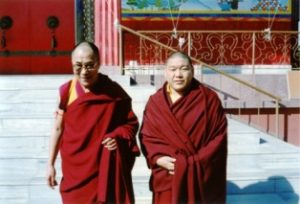 H.H. Dalai Lam with Beru KhyentseH.H. the Dalai Lama is also one of the teachers of Beru Khyentse Rinpoche. His Holiness gave all these teachings under the Bodhi tree with great compassion, wisdom and kindness. Since 1964, H.H. the Dalai Lama regularly visited Bodhgaya during winter season. Since Beru Khyentse Rinpoche’s main seat is in Mainpat, near to Bodhgaya, he used to visit there every year to attend all the teachings by His Holiness.
H.H. Dalai Lam with Beru KhyentseH.H. the Dalai Lama is also one of the teachers of Beru Khyentse Rinpoche. His Holiness gave all these teachings under the Bodhi tree with great compassion, wisdom and kindness. Since 1964, H.H. the Dalai Lama regularly visited Bodhgaya during winter season. Since Beru Khyentse Rinpoche’s main seat is in Mainpat, near to Bodhgaya, he used to visit there every year to attend all the teachings by His Holiness.
Since 1973, Beru Khyentse Rinpoche had been teaching and propagating Buddhism among western disciples by introducing and instructing them on refuge vows, Bodhisattva precepts, four foundation practices and various yidam prayers. At Bodhgaya in 1975, Rinpoche’s explanation and commentary on 9th Karmapa Wangchuk Dorje’s Mahamudra text ‘Eliminating the Darkness of Ignorance’ was translated and published in English by Rinpoche translator, Mr. Alexander. It became very popular all over the world and was later published in six other languages – French, German, Russian, Chinese, Spanish and Polish.
 Beru Khyentse’ sisterAnother translated book of Longchenpa’s Four Dharmas, includes commentary from His Holiness Dudjom Rinpoche on the upper part and commentaries on the lower part of the root texts by Beru Khyentse Rinpoche. This book also became popular worldwide. These two books are still available in many Dharma bookshops around the world.
Beru Khyentse’ sisterAnother translated book of Longchenpa’s Four Dharmas, includes commentary from His Holiness Dudjom Rinpoche on the upper part and commentaries on the lower part of the root texts by Beru Khyentse Rinpoche. This book also became popular worldwide. These two books are still available in many Dharma bookshops around the world.
In 1976, H.H. the Gyalwa Karmapa gave a big Kagyu Ngagzod Chenmo empowerment at Kar-Nying Shedrupling Monastery in Boudha , Nepal . Kagyu Ngagzod Chenmo is a collection of tantra treasures in Marpa Lotsawa’s tradition by the Great Jamgon Kongtrul. This empowerment was attended by many lamas such as Sharma Rinpoche, Jamgon Kongtrul Rinpoche, Gyaltsab Rinpoche, Beru Khyentse Rinpoche, Tulku Orgyen Rinpoche, Dzongsar Khyentse Rinpoche and many monks and laymen.
H.H. the Gyalwa Karmapa and the all the Rinpoches then returned to India from Nepal through Lumbini, the birthplace of Lord Buddha. On his return to the settlement in Mainpat, Beru Khyentse Rinpoche’s mother who had been unwell for sometime became serious ill and passed away at the age of sixty-nine, on the 18th of the fourth month of the Tibetan Calendar in 1976. All through her life, Rinpoche’s mother had recited Tara prayers and Chenrezig’s mantra “Om Mani Padme Hum” for more than a hundred and fifty million times. Throughout her life she has indulged in prayers and she was a very honest and humble lady with a natural compassion and a pure heart. Rinpoche and his monks performed the forty-nine days Puja for her. Rinpoche’s father, Ngawang Lobsang had passed away when Rinpoche was just six years old, before his recognition as the reincarnated tulku. Rinpoche’s elder sister Tsewang Dolma and her family are with Rinpoche at the Mainpat Tibetan settlement.
H.H. the Gyalwa Karmapa and his entourage comprising of Jamgon Kongtrul Rinpoche and many other lamas and monks arrived at Calcutta . H.H. the Gyalwa Karmapa extended His initial schedule of staying from three to five days in Calcutta , saying that five days should spent happily together. The reason for the extension is now obvious, that it was to advise them for the future, as it became His last meeting with some of his close disciples, like Namkhe Dorje and Beru Khyentse Rinpoche. H.H. the Karmapa made a prediction at that time that if he could stay for another ten years, it may be possible that he could convert the whole world to Buddhism. But His Holiness said, due to his failing health, it may not seem possible. Beru Khyentse Rinpoche then requested His Holiness to remain for hundreds of years. However, H.H. the Gyalwa Karmapa did not reply.
 His Holiness the 16th Karmapa with Beru Khyentse Rinpoche in New Delhi, January 1980.
His Holiness the 16th Karmapa with Beru Khyentse Rinpoche in New Delhi, January 1980.
On another occasion, an Indian palmist came to see His Holiness. He looked at Beru Khyentse Rinpoche’s palm and predicted great risks to Rinpoche life that year. The Gyalwa Karmapa heard that remark and told Rinpoche not to worry and that the palmist was lying. He further said that Jamgon Kongtrul and Beru Khyentse Rinpoche should both be more careful with vehicles in the future. He then gave each of them a red protection cord and advised them to always carry with them wherever they go. Previously in Rumtek, His Holiness has also presented every Rinpoche a bead from the rosary of the 15th Karmapa Khakhyab Dorje, who had recited Mahakala mantra throughout his life.
In 1992, when His Eminence Jamgon Kongtrul Rinpoche was killed in a car accident, it was said that this protection cord were not found on him. He had forgotten to wear it before the journey. It was found in the pocket of his attendant, who was the only person to survive the accident. Beru Khyentse Rinpoche had also met with a similar accident in Tibet . He was traveling to east Tibet , Kham through Nyenchen Thanglha Mountain area in the northern region of Tibet . The driver, who was very tired, fell asleep for a fraction of a second and lost control of the vehicle, which was moving at high speed. The vehicle rolled over twice before hitting a rock. The vehicle was completely damaged but fortunately all the other passengers survived without any injury. This miracle is due only to the protection cord of the Karmapa which Beru Khyentse Rinpoche had been wearing all the time.
Five men principal heart son of 16th Karmapa and Kagyu Lineage holder (From L-R) Beru Khyentse, Gyaltsapa, Jamgon Kongtrul, Tai Situ and Kunzeg Shamarpa, in Rumtek Sikkim Monastery of Karmapa, 1981.In August 1981, the Gyalwa Karmapa sent a letter to Beru Khyentse Rinpoche. About two months after sending this letter, His Holiness became seriously ill and went to Chicago for medical treatment. Unfortunately, due to diminishing merits of sentient beings and the lack of fortune of the disciples, His Holiness entered into parinirvana. His body remained in ‘Thukdham’ or post parinirvana meditation posture for three days. Thereafter, His Holiness’ ‘Kudhung’ or body was brought back to his main seat at Rumtek. Many high lamas from all the four schools and Sanghas paid respect to the ‘Kudhung’ by offering lamps, flowers and prayers. A grand forty-nine days puja was performed and on the final day of the puja, cremation of the ‘Kudhung’ was performed. During the forty-nine days prayer, Kyabje Kalu Rinpoche conducted a grand Kalachakra empowerment and oral transmission of the very rare secret teachings of ‘Martrid Zabmo’. After a few days, Pal Karma Shri Nalanda Institute for higher studies was inaugurated. The establishment of this Institute had been one of the wishes of Karmapa.
Since 1979, Beru Khyentse Rinpoche had traveled to many countries around the world to perform dharma activities. These countries includes, Australia, New Zealand, Malaysia, Singapore, Bangkok, Indonesia, Hong Kong, Philippines, Taiwan, China, France, Germany, Austria, Italy, Switzerland, England, Denmark, Norway, Sweden, Poland, Russia, Hungary, Spain, Holland, Belgium, Greece, Lebanon, Kuwait, Canada, North America, South America, Bhutan, India, Nepal and Rinpoche’s motherland, Tibet. In all these countries, Rinpoche had visited the major cities, towns and villages to spread Dharma in the non-sectarian Tibetan Buddhism tradition. Many of the Dharma centres and Buddhist communities in these countries invited Rinpoche to give teachings, empowerments, refuge vows and Bodhicitta vows. More than twenty thousand people become Buddhist practitioners and over a hundred and fifty thousand people received blessings, dharma teachings and empowerments from Beru Khyentse Rinpoche.
In 1999, Beru Khyentse Rinpoche performed a grand aspiration prayer for World Peace at Bodhgaya under the Bodhi Tree. Many Rinpoches, lamas, monks and nuns from all over India , Bhutan , Nepal and Tibet attended this prayer ceremony. Five hundred thousand lamps were offered in the Mahabodhi Stupa along with offering of flowers and incense. The merits from the puja were dedicated for the world peace, harmony and to pacify the disasters in the world. In the first week of January 2000, the official enthronement ceremony of the 4th incarnation of the Great Jamgon Kongtrul Lodro Thaye’s Yangsi Rinpoche, Karma Migyur Drakpa Senge, was held. The ceremony was held in Bodhgaya, the most holy Buddhist site in India at Beru Khyentse Rinpoche monastery.
His Holiness Pema Norbu Rinpoche, head of Nyingmapa Lineage, with Beru Khyentse Rinpoche and over seven thousand lamas of Nyingmapa Lineage, performing wishing prayer under the Bodhi Tree in Bodhgaya every year. Photo taken in January 2003.
In November 2002, Rinpoche performed the 5 days the Kalachakra empowerment with lama dance in Kuala Lumpur , Malaysia and the 3 days Chakrasamvara empowerment in Singapore.
In July 2003 Rinpoche gave the Kagyu Ngagzod of Marpa Lotsawa tradition in Nice Centre in France for 17 days.
By the merits of this virtuous action, may all the beings’ suffering in the lower realms be liberated and their mind dissolves with Khyentse Wangpo’s mind, who is the emanation of the Vimalamitra and Manjushri himself. May all beings achieve Buddhahood.
